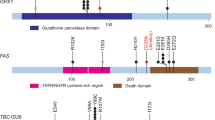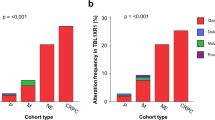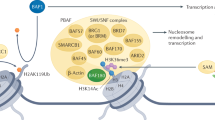Abstract
We searched for chromosome 3p homo- and hemizygous losses in 23 lung cancer cell lines, 53 renal cell and 22 breast carcinoma biopsies using 31 microsatellite markers located in frequently deleted 3p regions. In addition, two sequence-tagged site markers (NLJ-003 and NL3-001) located in the Alu-PCR clone 20 region (AP20) and lung cancer (LUCA) regions, respectively, were used for quantitative real-time PCR (QPCR). We found frequent (10–18%) homozygous deletions (HDs) in both 3p21.3 regions in the biopsies and lung cancer cell lines. In addition, we discovered that amplification of 3p is a very common (15–42.5%) event in these cancers and probably in other epithelial malignancies. QPCR showed that aberrations of either NLJ-003 or NL3-001 were detected in more than 90% of all studied cases. HDs were frequently detected simultaneously both in NLJ-003 or NL3-001 loci in the same tumour (P<3–10−7). This observation suggests that tumour suppressor genes (TSG) in these regions could have a synergistic effect. The exceptionally high frequency of chromosome aberrations in NLJ-003 and NL3-001 loci suggests that multiple TSG(s) involved in different malignancies are located very near to these markers. Precise mapping of 15 independent HDs in the LUCA region allowed us to establish the smallest HD region in 3p21.3C located between D3S1568 (CACNA2D2 gene) and D3S4604 (SEMA3F gene). This region contains 17 genes. Mapping of 19 HDs in the AP20 region resulted in the localization of the minimal region to the interval flanked by D3S1298 and D3S3623 markers. Only four genes were discovered in this interval, namely, APRG1, ITGA9, HYA22 and VILL.
This is a preview of subscription content, access via your institution
Access options
Subscribe to this journal
Receive 50 print issues and online access
$259.00 per year
only $5.18 per issue
Buy this article
- Purchase on Springer Link
- Instant access to full article PDF
Prices may be subject to local taxes which are calculated during checkout





Similar content being viewed by others
Abbreviations
- ACTB :
-
human β-actin gene
- AI:
-
allelic imbalance
- AP20:
-
Alu-PCR clone 20 region
- BC:
-
breast carcinoma
- C:
-
centromeric
- CC:
-
cervical carcinoma
- H-allele:
-
high-molecular-weight allele
- HD:
-
homozygous deletion
- L-allele:
-
low-molecular-weight allele
- LOH:
-
loss of heterozygosity
- LUCA:
-
lung cancer region
- MEC:
-
major epithelial carcinomas
- NSCLC:
-
non-small cell lung cancer
- PF2K :
-
phosph-fructo-2 kinase gene
- QPCR:
-
quantitative real-time PCR
- RCC:
-
renal cell carcinoma
- STS:
-
sequence-tagged site
- SCLC:
-
small-cell lung cancer
- T:
-
telomeric
- TSG:
-
tumour suppressor gene
References
Alimov A, Kost-Alimova M, Liu J, Li C, Bergerheim U, Imreh S, Klein G and Zabarovsky ER . (2000). Oncogene, 19, 1392–1399.
Angeloni D, Duh F-M, Moody M, Dean M, Zabarovsky ER, Sentchenko V, Braga E and Lerman MI . (2003). Mol. Cell. Probes, 17, 55–57.
Angeloni D and Lerman MI . (2001). Sourcebook on Asbestos Diseases, Vol. 23. Peters GA and Peters BJ (eds). Philadelphia: Lexis Nexis Press, pp 169–209.
Braga E, Pugacheva E, Bazov I, Ermilova V, Kazubskaya T, Mazurenko N, Kisseljov F, Liu J, Garkavtseva R, Zabarovsky E and Kisselev L . (1999). FEBS Lett., 454, 215–219.
Braga E, Senchenko V, Bazov I, Loginov W, Liu J, Ermilova V, Kazubskaya T, Garkavtseva R, Mazurenko N, Kisseljov F, Lerman MI, Klein G, Kisselev L and Zabarovsky ER . (2002). Int. J. Cancer, 100, 534–541.
Daigo Y, Isomura M, Nishiwaki T, Tamari M, Ishikawa S, Kai M, Murata Y, Takeuchi K, Yamane Y, Hayashi R, Minami M, Fujino MA, Hojo Y, Uchiyama I, Takagi T and Nakamura Y . (1999). DNA Res., 6, 37–44.
Danilkovitch-Miagkova A, Duh F-M, Kuzmin I, Angeloni D, Liu SL, Miller AD and Lerman MI . (2003). Proc. Natl. Acad. Sci. USA, 100, 4580–4585.
Erlandsson R . (1998). Cancer Genet. Cytogenet., 104, 1–18.
Girard L, Zochbauer-Muller S, Virmani A, Gazdar AF and Minna JD . (2000). Cancer Res., 60, 4894–4906.
Imreh S, Klein G and Zabarovsky E . (2003). Genes Chromosomes Cancer, 38, 307–321.
Ishikawa S, Kai M, Tamari M, Takei Y, Takeuchi K, Bandou H, Yamane Y, Ogawa M and Nakamura Y . (1997). DNA Res., 4, 35–43.
Kashuba VI, Gizatullin RZ, Protopopov AI, Li J, Vorobieva NV, Fedorova L, Zabarovska VI, Muravenko OV, Kost-Alimova M, Domninsky DA, Kiss C, Allikmets R, Zakharyev VM, Braga EA, Sumegi J, Lerman M, Wahlestedt C, Zelenin AV, Sheer D, Winberg G, Grafodatsky A, Kisselev LL, Klein G and Zabarovsky ER . (1999). Gene, 239, 259–271.
Kashuba VI, Szeles A, Allikmets RL, Nilsson AS, Bergerheim SR, Modi W, Grafodatsky A, Dean M, Stanbridge EJ, Winberg G, Klein G and Zabarovsky ER . (1995). Cancer Genet. Cytogenet., 81, 144–150.
Kashuba VI, Li J, Wang F, Senchenko VN, Protopopov A, Malyukova A, Kutsenko AS, Kadyrova E, Zabarovska VI, Muravenko OV, Zelenin AV, Kisselev LL, Kuzmin I, Minna JD, Winberg G, Ernberg I, Braga E, Lerman MI, Klein G and Zabarovsky ER . (2004). Proc. Natl. Acad. Sci. USA, 101, 4906–4911.
Kok K, Naylor SL and Buys CH . (1997). Adv. Cancer Res., 71, 27–92.
Lerman M, Minna J, Sekido Y, Bader S, Burbee D, Fong K, Forgacs E, Gao B, Garner H, Gazdar AF, Girard L, Kamibayashi C, Kondo M, Pande A, Ramalingam V, Randle D, Tomizawa Y, Virmani A, Wistuba I, Macartney D, Honorio S, Maher E, Latif F, Kashuba V, Protopopov A, Li J, Klein G, Zabarovsky E, Duh F-M, Wei M-H, Geil L, Kuzmin I, Ivanov S, Angeloni D, Ivanova A, Zbar B and Johnson BE . (2000). The International Lung Cancer Chromosome 3p21.3 Tumor Suppressor Gene Consortium. Cancer Res., 60, 6116–6133.
Lindblad-Toh K, Tanenbaum DM, Daly MJ, Winchester E, Lui W-O, Villapakkam A, Stanton SE, Larsson C, Hudson TJ, Johnson BE, Lander ES and Meyerson M . (2000). Nat. Biotechnol., 18, 1001–1005.
Liu J, Zabarovska VI, Braga E, Alimov A, Klein G and Zabarovsky ER . (1999). FEBS Lett., 462, 121–128.
Phelps RM, Johnson BE, Ihde DC, Gazdar AF, Carbone DP, McClintock PR, Linnoila RI, Matthews MJ, Bunn Jr PA, Carney D, Minna JD and Mulshine JL . (1996). J. Cell. Biochem., 24 (Suppl), 32s–91s.
Protopopov A, Kashuba VI, Zabarovska VI, Muravenko OV, Lerman MI, Klein G and Zabarovsky ER . (2003). Cancer Res., 63, 404–412.
Sambrook J, Fritsch EF and Maniatis T . (1989). Molecular Cloning: A Laboratory Manual. Cold Spring Harbour Laboratory Press: Cold Spring Harbor, NY.
Seabright M . (1971). Lancet, 7731, 971–972.
Senchenko V, Liu J, Braga E, Mazurenko N, Loginov W, Seryogin Y, Bazov I, Protopopov A, Kiseljov F, Kashuba V, Lerman MI, Klein G and Zabarovsky ER . (2003). Oncogene, 22, 2984–2992.
Stewart BW and Kleihues P . (2003). World Cancer Report. IARC Press: Lyon.
Van den Berg A and Buys CH . (1997). Genes Chromosomes Cancer, 19, 59–76.
Wei M-F, Latif F, Bader S, Kashuba V, Chen JY, Duh F-M, Sekido Y, Lee C, Geil L, Kuzmin I, Zabarovsky E, Klein G, Zbar B, Minna JD and Lerman MI . (1996). Cancer Res., 56, 1487–1492.
Wistuba II, Behrens C, Virmani AK, Meme G, Milchgrub S, Girard L, Fondon III JW, Garner HR, McKay B, Latif F, Lerman MI, Lam S, Gazdar AF and Minna JD . (2000). Cancer Res., 60, 1949–1960.
Wistuba II, Gazdar AF and Minna JD . (2001). Semin. Oncol., 28, 3–13.
Yang Q, Yoshimura G, Mori I, Sakurai T and Kakudo K . (2002). J. Hum. Genet., 47, 453–459.
Zabarovsky ER, Lerman MI and Minna JD . (2002). Oncogene, 21, 6915–6935.
Zöchbauer-Muller S, Gazdar AF and Minna JD . (2002). Annu. Rev. Physiol., 64, 681–708.
Acknowledgements
This work was supported by research grants from the Swedish Cancer Society, the Swedish Research Council, the Swedish Foundation for International Cooperation in Research and Higher Education (STINT), Karolinska Institute, Åke Wibergs Stiftelse, the Royal Swedish Academy of Sciences, the Swedish Institute, INTAS, the Russian Foundation for Basic Research (Grant 01-04-48028), the research programme of Russian Academy of Science ‘Basic Science to Medicine’ and Russian Ministry of Science and Technology. MIL and DA were funded in toto with funds from the National Cancer Institute, National Institutes of Health, under Contract No. NO1-CO-56000. JDM was supported by Grants P50CA70907 and CA71618. The content of the publication does not necessarily reflect the views or policies of the Department of Health and Human Services, nor does mention of trade names, commercial products or organizations imply endorsement by the US Government.
Author information
Authors and Affiliations
Corresponding author
Rights and permissions
About this article
Cite this article
Senchenko, V., Liu, J., Loginov, W. et al. Discovery of frequent homozygous deletions in chromosome 3p21.3 LUCA and AP20 regions in renal, lung and breast carcinomas. Oncogene 23, 5719–5728 (2004). https://doi.org/10.1038/sj.onc.1207760
Received:
Revised:
Accepted:
Published:
Issue Date:
DOI: https://doi.org/10.1038/sj.onc.1207760
Keywords
This article is cited by
-
Role of the Neanderthal Genome in Genetic Susceptibility to COVID-19: 3p21.31 Locus in the Spotlight
Biochemical Genetics (2024)
-
Clinicopathological Significance of Overall Frequency of Allelic Loss (OFAL) in Lesions Derived from Thyroid Follicular Cell
Molecular Diagnosis & Therapy (2019)
-
DLEC1 methylation is associated with a better clinical outcome in patients with intrahepatic cholangiocarcinoma of the small duct subtype
Virchows Archiv (2019)
-
miR-138-1* regulates aflatoxin B1-induced malignant transformation of BEAS-2B cells by targeting PDK1
Archives of Toxicology (2016)
-
Assessment of the frequency of genetic alterations (LOH/MSI) in patients with intraepithelial cervical lesions with HPV infection: a pilot study
Medical Oncology (2016)



